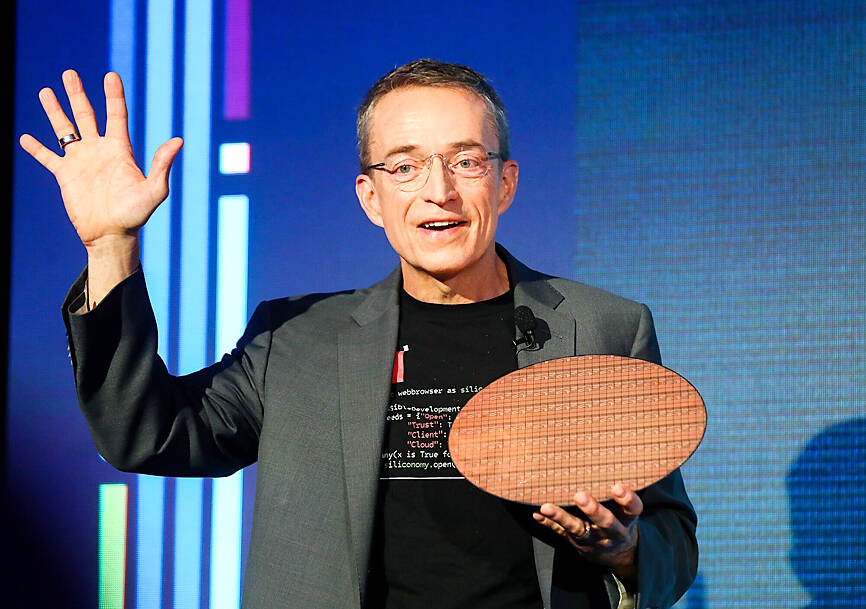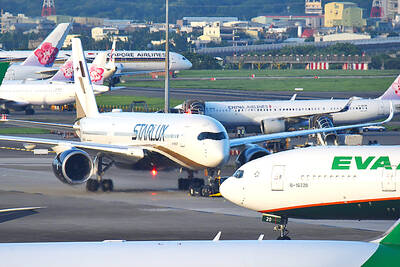Intel Corp is expanding semiconductor capacity in the US, Europe and Asia as part of its efforts to satisfy the world’s need for a geographically balanced supply chain, while Taiwan has built itself into a foundry hub of Asia, CEO Pat Gelsinger told a media briefing in Taipei yesterday.
As a major part of its IDM2.0 (integrated device manufacturing) strategy, Intel aims to become a leading foundry service supplier to the world, Gelsinger said.
Taiwan has strong foundry companies, but Intel believes that “as the world wants a resilient geopolitical balanced supply chain, so our strategy is to align with that,” Gelsinger said. “Other than a strong Asian supply chain, with the hub built in Taiwan, there will be the need for a strong supply chain in America and Europe.”

Photo: Bloomberg
To address such needs, the US chipmaker is building a diverse manufacturing network around the world with multiple manufacturing operations in the US, Europe and Asia, he said.
In the US, Intel is building new fabs in Oregon, Arizona, New Mexico and Ohio, he said. The company also operates fabs in Israel and has unveiled major investment plans in Ireland, Poland and Germany to build leading-edge semiconductor factories, he said.
In Asia, Intel is expanding its footprint in Malaysia and Vietnam. The chipmaker is deploying wafer-level assembly and chip packaging manufacturing capabilities in Malaysia, Gelsinger said.
Intel’s investment in building geographically diversified fabs is well justified, as the global semiconductor market is expanding rapidly and is expected to reach an estimated US$1 trillion by the end of this decade from US$600 billion last year, he said.
To become a reliant foundry service provider, Gelsinger said Intel has to be “customer-obsessed,” as it has to become customers’ factories.
“No matter what, a good factory is making products that make their customers successful. Intel was never customer-oriented. We were a leadership technology provider,” Gelsinger said.
Commenting on growing competition from computers powered by ARM-based chips, Gelsinger said ARM has been unable to gain a sizeable share of the world’s PC market. At the same time, a growing number of companies are ushering into artificial-intelligence-enabled PCs, and Intel expects shipments of AI PCs to rise to 100 million units in 2025, he said.
Intel sees ARM-based chipmakers as potential customers of its foundry services, given that Intel’s OpenVINO, an open-source toolkit for optimizing and deploying AI inference, supports the ARM architecture, he said.
Gelsinger also told Intel’s local partners in Taipei that the company is confident about reaching its goal of delivering five advanced process nodes in four years. After successfully shipping the first node, the Intel 7 processor, Intel is on schedule to ramp up production of the Intel 18A, the last node of the plan, in the second half of next year.
Gelsinger took the reign of Intel in 2021.
Showing support for Intel, Asustek Computer Inc (華碩) chairman Jonney Shih (施崇棠) yesterday demonstrated the generative AI features on PCs.

RECYCLE: Taiwan would aid manufacturers in refining rare earths from discarded appliances, which would fit the nation’s circular economy goals, minister Kung said Taiwan would work with the US and Japan on a proposed cooperation initiative in response to Beijing’s newly announced rare earth export curbs, Minister of Economic Affairs Kung Ming-hsin (龔明鑫) said yesterday. China last week announced new restrictions requiring companies to obtain export licenses if their products contain more than 0.1 percent of Chinese-origin rare earths by value. US Secretary of the Treasury Scott Bessent on Wednesday responded by saying that Beijing was “unreliable” in its rare earths exports, adding that the US would “neither be commanded, nor controlled” by China, several media outlets reported. Japanese Minister of Finance Katsunobu Kato yesterday also

Taiwan’s rapidly aging population is fueling a sharp increase in homes occupied solely by elderly people, a trend that is reshaping the nation’s housing market and social fabric, real-estate brokers said yesterday. About 850,000 residences were occupied by elderly people in the first quarter, including 655,000 that housed only one resident, the Ministry of the Interior said. The figures have nearly doubled from a decade earlier, Great Home Realty Co (大家房屋) said, as people aged 65 and older now make up 20.8 percent of the population. “The so-called silver tsunami represents more than just a demographic shift — it could fundamentally redefine the

China Airlines Ltd (CAL, 中華航空) said it expects peak season effects in the fourth quarter to continue to boost demand for passenger flights and cargo services, after reporting its second-highest-ever September sales on Monday. The carrier said it posted NT$15.88 billion (US$517 million) in consolidated sales last month, trailing only September last year’s NT$16.01 billion. Last month, CAL generated NT$8.77 billion from its passenger flights and NT$5.37 billion from cargo services, it said. In the first nine months of this year, the carrier posted NT$154.93 billion in cumulative sales, up 2.62 percent from a year earlier, marking the second-highest level for the January-September

‘DRAMATIC AND POSITIVE’: AI growth would be better than it previously forecast and would stay robust even if the Chinese market became inaccessible for customers, it said Taiwan Semiconductor Manufacturing Co (TSMC, 台積電) yesterday raised its full-year revenue growth outlook after posting record profit for last quarter, despite growing market concern about an artificial intelligence (AI) bubble. The company said it expects revenue to expand about 35 percent year-on-year, driven mainly by faster-than-expected demand for leading-edge chips for AI applications. The world’s biggest contract chipmaker in July projected that revenue this year would expand about 30 percent in US dollar terms. The company also slightly hiked its capital expenditure for this year to US$40 billion to US$42 billion, compared with US$38 billion to US$42 billion it set previously. “AI demand actually